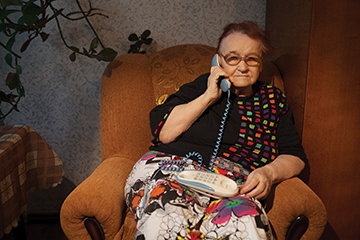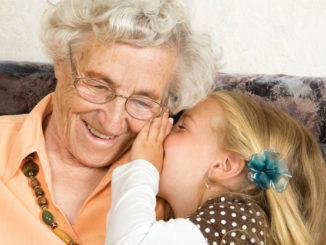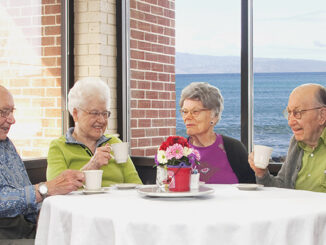
Caring for your aging family member or loved one from afar is no easy task, and taking the time to make sure your loved one is safe, secure and happy can cause long-distance caregivers to feel not only overwhelmed but riddled with guilt.
At Timesavers, our clients’ families contend with those feelings constantly.
While those feelings of guilt and anxiety are common when caregiving from a distance, there are numerous methods and resources available to long-distance caregivers to provide relief, comfort and security for both the caregiver and recipient of care.
With planning, research and consistency, long-distance caregivers can be there for their aging loved ones, regardless of the physical distance between the two.
According to the AARP, roughly one in eight family caregivers live more than an hour’s drive from the recipient of care. While caregivers may live away from their loved ones for many reasons – maybe a better job prospect caused you to relocate, or maybe your parents moved 10 hours to Florida in retirement – it can be difficult for caregivers to balance both aspects of their lives.
Those feelings are especially inflated when it comes to finances. Experts say it costs more for long-distance caregivers than it does for caregivers who live an hour or less from their loved ones.
“Long-distance caregivers spend nearly twice as much on caregiving as do people caring for a loved one close by,” the AARP says. “That’s because they’re more likely to need to hire help, take uncompensated time off work, and pay for travel.”
While it may be costly at times – the truth is, you’re going to need help when caregiving from afar. And in most parts of the country, there are plenty of resources available to assist you.
One option is to hire a reputable caregiving professional – someone who can be there when you can’t. These are sometimes called geriatric care managers, aging life care managers or eldercare navigators or coordinators.
“These professionals are often licensed social workers or nurses and can be valuable mediators or sounding boards when family members disagree on care decisions or when you’re facing tough choices, such as whether it’s no longer safe for your loved one to live at home,” the AARP says.
When selecting a caregiving professional, long-distance caregivers should work out the logistics before hiring, such as verifying credentials, discussing availability and areas of expertise, and considering costs. Costs for these professional services range from $50 to $200 an hour.
One of the most important ways you can love from a distance is by planning for emergencies. Emergencies can happen at any time, but planning for them will provide everyone a sense of comfort all of the time.
Knowing the basics of emergencies – is there a trustworthy person who’s able to get into the home when you’re not there? Does your loved one have an alarm for their residence? – can help greatly. Experts say there are little things you can do – such as distributing a couple of extra sets of house keys to trustworthy neighbors and family members – that can reduce stress and increase emergency preparedness.
You should also keep a trustworthy neighbor’s phone number on hand and have them do the same with your contact information. Creating relationships with the neighbors of your loved ones can serve as a regular source of comfort for everyone.
According to the National Institute on Aging, long-distance caregivers should delegate specific roles to other family members and friends when possible, especially if your loved one has more severe health issues.
“Beyond medical professionals, build a team by reaching out to family members, friends and community groups to form a network of caregiving helpmates,” the NIA suggests. “Determine roles. Ask what tasks team members are willing to do. A neighbor might cut the lawn, while another family member might volunteer to drive to doctor appointments.”
Having access to and organizing your aging loved one’s most important documents is critical when it comes to caregiving from a distance. When living miles apart, it’s extremely important that long-distance caregivers have all of their loved one’s medical, financial and legal paperwork both in order and up-to-date.
While gathering and organizing that paperwork can feel like a challenging task initially, especially when doing it from a distance, it will help you and your family in the long run.
“Once everything is gathered together, caregiving can be much easier,” the NIA says. “It allows you to get a good handle of what’s going on and a quicker response time to emergencies. Gather the essentials first. Make sure all financial matters – including wills and life insurance policies – are in order. It helps if someone has a durable power of attorney.”
Sometimes, your aging parent or relative may be reluctant to give up their personal information. For many, this part of the aging process can be challenging, scary and eye-opening for a variety of reasons.
The best way to handle those situations is simple: talk to your loved one about what’s going on. Experts say honesty is the best policy for confronting the reluctance that stems from sharing personal information.
“Explain that you’re not trying to invade their privacy or take over their personal lives,” the NIA explains. “You are only trying to assemble what will be needed in the event of an emergency. Assure them you will respect their privacy and keep your promise.”
No matter how many miles may be between you and your loved one, maintaining contact is essential to both the aging process and the mental health of everyone involved. No matter how busy life gets, planning in-person visits with your aging parent or relative should be a priority when caregiving from a distance.
While you’re in town, try to schedule a time to speak with your loved one’s primary caregiver to get medical updates about his or her cognitive and physical health. Moreover, take some time during the visit to see if anything around the residence needs fixing or replacing. Check out your mom’s closet to see if she needs anything new for the upcoming winter, and make sure your dad’s plumbing and air-conditioning are running well.
You can’t do everything in a single visit, but even taking those quick glances around can help you prioritize what you can handle this time around and what can wait.
But visits shouldn’t be all about the logistics and fix-its. When you’re there, try to make time for things unrelated to caregiving.
The NIA suggests watching a movie, planning a visit with old friends or family members, attending worship services, and playing cards or board games as ways to enjoy time together. Other activities, such as taking a drive together, can be simple, effective and relaxing.
And when talking to your loved one – whether in-person or by phone and email – be sure to ask them questions about their life and fill them in on what is going on with your life as well. Not every phone call has to be time-consuming. A Sunday afternoon check-in can be a short, easy phone call that takes five minutes or less, but it can help maintain a healthy relationship.
When you can’t make the visit in person, use the technology at your fingertips to schedule telehealth visits with your loved one’s onsite caregiver. If they live in a nursing home, schedule a Zoom call with the staff. Social workers can also be good resources to use when it comes to those challenging decision-making moments.
If video chats are a little technologically advanced for your aging relative, a phone call can always do the trick. Some organizations suggest setting your loved one up with a cell phone, if possible.
“Giving your grandmother a cell phone can provide peace of mind. A private phone line can help someone in a nursing home stay in touch. These simple strategies can be a lifeline,” the NIA says.
Over the past year, many of our aging loved ones have had to cope with an ever-changing visitation system, and, inevitably, those changes have affected everyone involved. With the COVID-19 pandemic having placed visitation restrictions on long-term care facilities, knowing how to be a long-distance caregiver is more relevant and crucial than ever.
-by Sherri Howell, Timesavers Director of Operations
and
Katie Pickens, Guest Writer




